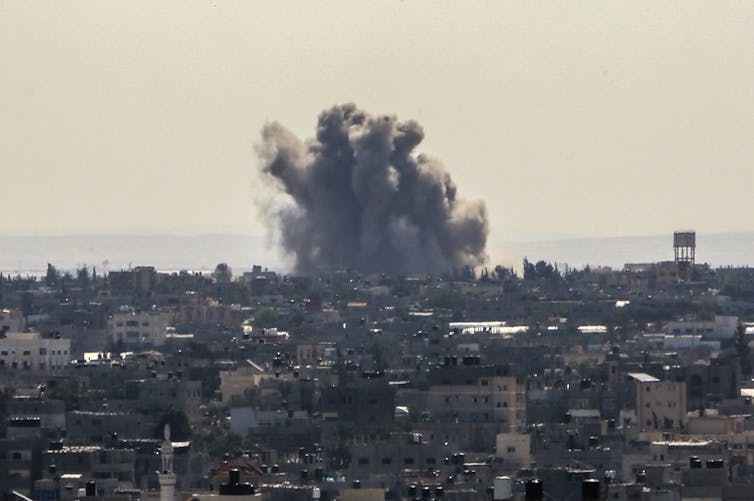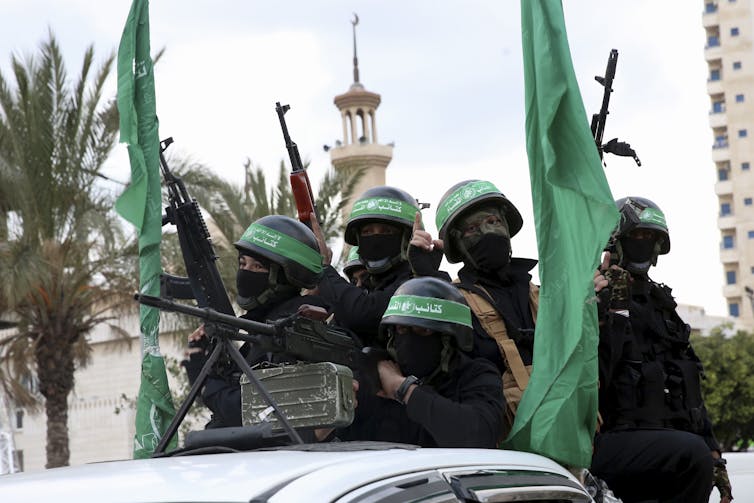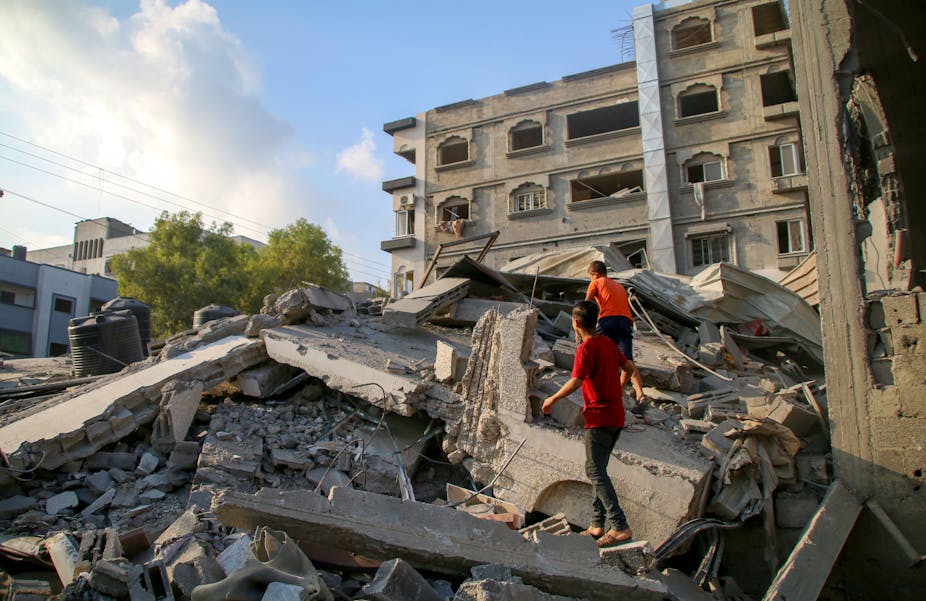The killing of Israeli civilians by Hamas and retaliatory airstrikes on the densely populated Gaza Strip by Israel raises numerous issues under international law.
Indeed, President Joe Biden made express reference to the “laws of war” in comments he made at the White house on Oct. 10, 2023, noting that while democracies like the U.S. and Israel uphold such standards, “terrorists” such as Hamas “purposefully target civilians.” Speaking the same day, the European Union’s top diplomat Josep Borrell condemned Hamas’ attack but also suggested that Israel was not acting in accordance with international law by cutting water, electricity and food to civilians in Gaza.
But international law and the very nature of the conflict itself – along with the status of the two sides involved – is a complex area. The Conversation turned to Robert Goldman, an expert on the laws of war at American University Washington College of Law, for guidance on some of the issues.
What are the ‘laws of war’?
The laws of war, also known as International Humanitarian Law (IHL), consist of the four 1949 Geneva Conventions, their two Additional Protocols of 1977, the Hague Conventions of 1899 and 1907, as well as certain weapons conventions.
Simply put, these instruments seek to spare civilians and others who are no longer active combatants from the effects of hostilities by placing restrictions and prohibitions on the conduct of warfare.
It is important to understand that modern IHL is not concerned with the reasons for, or the legality of, going to war. Rather, that is governed by the United Nations Charter and a member state’s own practice.
It is also important to note that violations of the laws of war are notoriously hard to prosecute and can be frustrated by lack of cooperation by the parties involved.
What is the nature of the conflict between Israel and Hamas?
The answer to this question is by no means clear.
Many humanitarian law experts would argue that Hamas and Israel are engaged in what is known as a “non-international armed conflict.” In other words, it would be classified the same way as a civil war that pits the armed forces of a state against an armed non-state actor, rather than an international conflict between two or more sovereign states.
If that were the case, the conflict would not be governed by the entirety of the laws of war, but instead by the more limited Common Article 3 of the Geneva Conventions along with numerous customary law rules, which derive from general practices accepted as law. Common Article 3, which applies to civilians and those no longer fighting, prohibits practices such as torture, summary execution and denial of a fair trial. But Prisoner of War status only applies to conflicts between states so would not apply.
But some international observers, including the United Nations, view Israel as, in effect, occupying Gaza – a view predicated on the fact that Israel controls Gaza’s borders and airspace and it supplies most of its electricity.
If that is the case, then the recent outbreak of hostilities between Hamas and Israel would trigger the entirety of laws of war.
That said, I do not believe that Israel is an occupying power in Gaza under a strict reading of the law. This is because Israel ceased governing and pulled its forces out of Gaza in 2005. Since 2007, Hamas, after expelling the Palestinian Authority, has in effect governed Gaza.
Is the bombing of Gaza illegal under international law?
Today the rules governing the conduct of hostilities in both international and non-international armed conflicts are essentially the same.
The foremost requirement in all conflicts is that combatants must always distinguish between civilians and combatants, and that attacks can only be directed at combatants and other military targets.

Protecting civilian populations caught in warfare essentially depends upon three factors:
- Civilians must abstain from fighting;
- The party in control of the civilian population must not place them at heightened risk of harm by using them as human shields; and
- The attacking force must take precautions to avoid or minimize excessive civilian casualties when attacking lawful targets.
Not only are civilians in Gaza not lawful targets, they are also protected under IHL by the rule of proportionality. This rule prohibits an attack against a military target which foreseeably could cause civilian casualties that are excessive, or disproportionate in relation to the advantage anticipated from the target’s destruction.
In the case of Gaza, this rule requires that before launching an attack, the Israeli military analyze and determine the likely effect on civilians. If it appears that such an attack will cause disproportionate civilian casualties, then it must be suspended or canceled.
Given Gaza’s urban density, it will be extremely difficult for the Israelis to avoid substantial civilian casualties even when using precision weapons.
And this task will be nearly impossible if Hamas, as it has consistently done in the past, uses civilians and now hostages to shield military targets.
While Israel bears primary responsibility to avoid excessive civilian deaths in its bombardment of Gaza, Hamas’ ability to claim the bombardment constitutes a war crime would be weakened if it deliberately places its own people in harm’s way.
And while Israel is complying with its duty to give an advanced warning of an attack in north Gaza, the problem remains: Where do 1 million people go to seek safety when borders are closed and military targets are being hit throughout Gaza?
Is Israel’s siege of Gaza illegal?
Unlike in the past, total siege warfare now is unlawful regardless of whether the warring parties are involved in international or non-international hostilities.
Blocking the entry of all food, water, medicines and cutting off electricity – as appears to be happening in Gaza – will disproportionately affect civilians, foreseeably leading to their starvation. This is a banned method of warfare under customary and conventional IHL.
No matter how horrific the actions of Hamas, IHL does not permit an aggrieved party to respond in kind. Violation of the law by one party cannot, in principle, justify or sanction actions by the other that violate established prohibitions in international humanitarian law.
What are the status and obligations of Hamas under IHL?
IHL rules apply equally to all the warring parties irrespective of the nature of the conflict. This means that Israeli and Hamas combatants have the same rights and duties.
If, however, the conflict is non-international, then Hamas will be regarded as an armed non-state actor and its combatants ineligible for Prisoner of War status upon capture. Accordingly, Israel can try them for all their hostile acts whether or not Hamas complies with the laws of war.

But even if the conflict is an international one, then Hamas’s fighters would still be debarred from Prisoner of War status. They are not the armed forces of Palestine – which is recognized as a state by 138 nations and has the Palestine Authority as its government.
Rather, Hamas combatants are an irregular armed group. To be eligible for Prisoner of War status under Article 4A(2) of the Third Geneva Convention, members of an irregular armed group must adhere to very strict standards, both collectively and individually. These includes distinguishing themselves from civilians and complying with the laws of war. Manifestly Hamas has not and does not meet these standards. As such, Israel could lawfully deny them Prisoner of War status upon capture.
Israel, the U.S. and others label Hamas fighters as terrorists. Hamas’ recent acts – indiscriminately firing thousands of rockets into Israel, targeting, killing and taking civilians as hostages – are acts of terrorism in warfare and qualify as war crimes.


